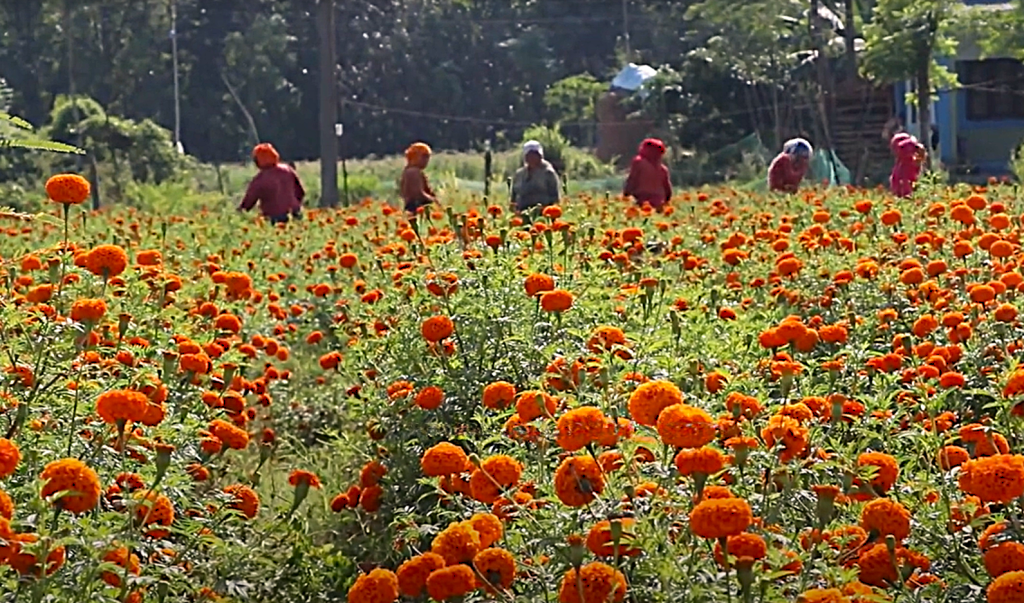
As Nepal approaches Tihar, the festival of lights, colors, fragrance, and smiles have begun to spread across the country. From courtyards adorned with marigolds, velvet flowers, and Godavari blooms to the narrow streets of the capital, flowers are bringing the festive spirit alive. At this time, the flower trade in Nepal reaches its annual peak, with the emotional value attached to flowers coloring both the market and hearts.
This year, the five-day Tihar festival is expected to see flower trade worth around NPR 400 million. According to the Floriculture Association Nepal (FAN), approximately 4 million flower garlands are sold during the festival, with the highest demand for velvet (makhamali) and marigold (sayapatri) flowers. Nepal is now fully self-reliant in velvet and Godavari flowers, and business representatives claim 90% self-sufficiency in marigolds. Apart from a small number of imported flowers, the fragrance of Tihar is now emanating from domestic gardens.
Self-Reliance in Flowers: Beyond Business
Flower self-sufficiency is not only a commercial achievement—it symbolizes local enterprise, women’s empowerment, and rural employment. Spread across 270 hectares in 52 districts, the floriculture sector now supports thousands of families. More than 12,000 entrepreneurs and over 50,000 people are directly or indirectly employed in this sector. With an annual trade exceeding NPR 3 billion, the industry is thriving despite economic challenges.
The government’s three-year ban on legally importing flowers from India has further increased the value and significance of domestic flowers. While imports were restricted due to a lack of pest- and disease-free certificates, this policy has provided Nepali producers with a bouquet of opportunities. Local municipalities and the Kathmandu Metropolitan City have prioritized domestic flowers, establishing sales centers to promote local production. Consequently, the dream of a “Flower Self-Reliant Nepal” is no longer symbolic but becoming a tangible reality.
Fragrance of Domestic Flowers
From the capital to rural markets, domestic flowers are now coloring both festivals and the economy. Over the past few years, flower production and consumption have grown steadily. According to FAN, floriculture now spans roughly 270 hectares nationwide, generating an estimated NPR 3 billion annually. Around 12,000 businesses and more than 50,000 people are engaged directly or indirectly in this industry.
Major flower production centers include Kathmandu Valley, Chitwan, Pokhara, Dharan, Biratnagar, Nepalgunj, and Hetauda. Flowers from these regions are used in Tihar, Holi, weddings, and other cultural and religious events. Business representatives note that flower production has steadily increased over the past three years, driven primarily by public trust in domestic flowers and the ban on Indian flower imports.
FAN president Rajeshbhakta Shrestha says, “We no longer need to import flowers from India. Nepali farmers’ labor is fully meeting market demand. This is a direct example of self-reliance.” He added that Nepal is now completely self-sufficient in velvet and Godavari flowers, and 90% of marigolds are produced domestically.
Market Trends and Tihar Demand
During Tihar, about 4 million garlands are expected to be sold, with a market value reaching NPR 400 million. Flowers are now not just decorations but symbols of domestic self-reliance and rural entrepreneurship.
Flower markets nationwide—from Bhrikutimandap, Bagbazar, Kalimati, and Kupandol in Kathmandu to Pokhara, Chitwan, and Dharan—are bustling with activity. Velvet and marigold garlands remain in highest demand, with Godavari, rose, and gerbera sales also increasing rapidly.
Compared to last year, flower prices have increased 15–20% due to higher production costs, labor shortages, and transportation expenses. Currently, a one-meter marigold garland sells for NPR 50–70, while a velvet garland costs NPR 30–50. Online orders via mobile apps have surged, particularly from corporate offices and younger consumers, reshaping market dynamics.
FAN officials note, “Buying flowers is no longer limited to religious rituals; it has become part of gifts and lifestyle.” Around 70% of garland sales are expected to be concentrated in the Kathmandu Valley, with many consumers preferring domestic flowers, providing stability to the import-free market.
Government Policy and Domestic Opportunities
Government policies have played a decisive role in promoting self-reliance in flower production. In 2022, authorities imposed a temporary ban on flower imports from India to prevent pest and disease contamination and ensure phytosanitary compliance. While initially challenging, the policy allowed Nepali producers to expand domestic production. FAN reports a 20% increase in flower cultivation area following the import ban, as farmers shifted from traditional crops to floriculture.
Local governments and federal authorities have supported the sector through initiatives such as distribution of seeds, technical support, and greenhouse subsidies. Some provinces have also categorized floriculture as a “special agricultural industry.”
However, policy continuity remains critical. Business representatives warn that without stable regulations, self-reliance may be temporary. FAN advisors emphasize, “Flower self-reliance is not a one-year achievement; continuous policy support and protection are essential.”
Women’s Empowerment in Floriculture
Women’s participation in Nepal’s floriculture sector has significantly increased over the past decade. Female farmers across rural and urban areas produce flowers not only for home use but also as a source of income. Approximately 45% of flower entrepreneurs nationwide are women, operating nurseries and wholesale shops in Kathmandu, Bhaktapur, and Lalitpur.
Women predominantly grow velvet, Godavari, and marigold flowers, targeting festivals like Tihar and Deepawali. Their involvement ensures that 30–35% of flower businesses are female-led, contributing to both economic empowerment and social recognition. FAN president Shrestha adds, “Women investing in floriculture gain not only financial profit but also social respect and self-reliance.”
Economic Impact and Employment
FAN data shows that floriculture spans 270 hectares across 52 districts, engaging over 12,305 businesses involved in nurseries, cut-flower production, wholesale and retail trade, input supply, and loose flower production. Around 53,500 people are directly or indirectly employed in the sector.
The annual trade contributes roughly NPR 3 billion to the national economy, with a 10–15% annual growth rate. Post-COVID recovery, combined with technical assistance and policy reforms, has allowed the sector to expand further. Investment in floriculture now exceeds NPR 883 million, underscoring its importance to both rural and urban economies.
Flower Expos and Market Trends
Tihar-focused flower expos provide platforms for producers and consumers. The Third Tihar Flora Expo 2082 at Bhrikutimandap attracted over 35,000 visitors, generating millions in trade. Similarly, the 18th Godavari Flower Competition in Jawalakhel drew over 40,000 visitors. These events boost business, showcase flower diversity, and promote home, office, and public usage.
Seed Independence and Government Support
Despite strides in flower self-reliance, 80–85% of flower seeds are still imported. FAN and industry experts urge domestic seed production to ensure long-term sustainability. The Ministry of Agriculture and Livestock Development has begun registering flower varieties, with 350 species registered last year. Secretary Dr. Govinda Prasad Sharma emphasizes formal registration and organized market development to further strengthen the sector.
Nepal’s floriculture industry has grown beyond cultural and religious significance to become a critical economic sector, fostering rural employment, women’s entrepreneurship, and youth engagement. With government policy support, local initiatives, and private investment, domestic flowers are now central to Tihar celebrations and the country’s broader goal of self-reliance.











